Agonis flexuosa



Fissured or Wrinkled
Fissured bark forms long narrow divisions causing separations. Wrinkled bark generally has smooth folded appearance that may be warty.
Small dome / Mallee
A shrub to small tree with a rounded crown and with or without multiple trunks.This small tree has rough brown bark with multiple trunks that branch out into a graceful weeping crown. It has thin light green lanced-shaped leaves and small white saucer-shaped flowers appear in a cluster along the branches during spring.
Agonis flexuosa is naturally found in south-western Western Australia growing in coastal regions and in Jarrah forests from Perth to Albany. It prefers very well drained moderately fertile white or grey sandy soil amongst granite outcrops but will tolerate heavy clay soil with a pH range from 5.5 to 7.5. It grows in an open to exposed sunny position and is drought and frost tolerant.
Willow Myrtle is grown for its pendant crown and its small white flowers. It is planted as a specimen tree along borders as a wind break and is suitable for second line coastal positions. It is used in parks and large gardens as a shade tree or planted along water courses. This long lived tree establishes in 2 to 4 years and is commonly seen as an understorey tree in wet forests. Under ideal conditions it self-sows and can become weedy. It has a low water requirement once established. (Scale: 1-drop from 3) but will tolerate both dry or wet conditions.
ID 75
UK hardiness zone H2
Climate zones 15, 16, 17, 20 - 24
USDA Zone 9-10
Agonis (AG-on-iss) flexuosa (fleks-yoo-OH-suh)
Greek for "without angles", referring to the weeping habit; "flexuosa", from the Latin word for "wavy" or "bent", referring to the zig-zag pattern made by the twigs.
var. latifolia
This small tree differs from the species by having short broad leaves.
There are many cultivars of this plant and all are tolerant of most well drained soils and positions.
Cultivars
‘After Dark’
This low growing bushy weeping shrub has dark purplish foliage and produces white scented flowers during spring. It is used for colour contrast along garden borders
'Fairy Foliage'
This shrub form grows to 4 m (12 ft) tall and produces distorted linear leaves. It is planted in shrub borders for foliage contrast and has a low water requirement once established. (Scale: 1-drop from 3)
'Nana'
This is a dwarf evergreen shrub grows to 1 m (3 ft) tall and is suitable for coastal regions growing in full sun on well drained moderately fertile moist soils. It is planted in small gardens along borders and has a low water requirement once established. (Scale: 1-drop from 3)
'Variegata'
This small tree has cream pink striped leaves but the lacks vigour of the species.
'Weeping Wonder' syn. 'Demmark Delight'
This dwarf pendulous shrub to 1 m (3 ft) tall produces reddish new growth. It is grown in borders for screening and is suitable for coastal regions. It has a low water requirement once established (Scale: 1-drop from 3), responding to mulch and an occasional deep watering during dry periods.

Myrtaceae (mir-TAY-see-ee)
Myrtle, Eucalyptus, Clove and Guava Family
This is a large family of shrubs, mallee and trees with showy stamens and peeling bark. It has a large representation in the Australian landscape.
Distribution
The plants in this family are predominantly found in the southern Hemisphere with 75 genera native to Australia and the remaining distributed in South America, Africa and the neighbouring islands. They are located in tropical rainforests, sclerophyll, heaths and woodlands in rich to poor dry soils.
Diagnostic Features
The simple leaves are normally opposite; occasionally spirally arranged with no stipules and normally an entire margin. There are pellucid oil glands dotted on the leaf, which may be obscured and when the leaf is crushed it is aromatic.
The juvenile, intermediate and adult leaves may be different in arrangement and shape on the same plant.
The regular flowers are hermaphrodite or sometimes unisexual and may be axillary, solitary, or arranged in cymes, umbles, terminal spikes, racemes or panicles. The floral tube covers the ovary and may continue above the ovary summit and form a disk around the ovary.
There are 4 to 5 sepals and petals normally fused to form a calyptra or are free.
The stamens are five to many and may be free or fused into 5-bundles that are opposite the petals.
They have an inferior to semi-inferior ovary that has 1 to 10 carpels, normally five with 1 to many ovules that are inserted on an axil that is basal or rarely a parietal placenta.
The style ends with a narrow stigma and the anthers normally open with longitudinal slits or pores.
The fruit may be a capsule, berry, nut or drupe-like with the cup that surrounds the ovary that is fleshy or dry and woody.
The seed may vary in structure and the cotyledons may be small or large.
Note:
This family has many attractive species and are extensively used in ornamental. Eucalyptus, Melaleuca, Callistemon and Thryptomrnes are just some of the plants represented and they are normally pollinated by insects, birds and in some cases by mammals.
This plant tolerates between USDA zones 9a to 10a and grows to 10 m (30 ft)
Fahrenheit 20º to 30º F
These temperatures represent the lowest average.
Celsius -3.9º to -1.1º C

Attention
The information displayed on this plant is based on research conducted in our horticultural library and from reliable online resources. We also make observations of the plant that we photograph, and all care is taken to ensure the details are correct.
All photographs and data are covered by copyright. Apart from any fair dealing for the purpose of private study, research, reference or review, as permitted under the Copyright Act, no part including images and text may be reproduced by any means without written permission. The information presented in the map is only indicative and may contain errors and omissions. All inquiries should be addressed to sales@plantfile.com attention Peter Kirkland.

Simple
The leaf that is not divided.
Lanceolate
Broadest at the centre, three or more times long as broad (Lance-shape).
Alternate
Leaves are arranged alternately along the stem.
Entire
A leaf margin with no irregularities (smooth).
Crateriform
A saucer shaped hollow.
Cluster or Fascicle
A general term describing flowers that are arranged in closely packed bunches.| Jan | Feb | Mar | Apr | May | Jun |
| Jul | Aug | Sep | Oct | Nov | Dec |
The small crateriform white flowers are up to 9 mm (3/8 in) wide and are arranged in groups of 10 to 14 in a sessile, axillary globular cluster that appears during spring.

Capsule
A dried dehiscent fruit, with an enclosing membrane normally containing may seeds."Willow Myrtle is grown for its habit and planted as a specimen tree along borders as a wind break and in second line coastal plantings. It is also used for foliage contrast and it can be grown in heavy clay soil. This tree will establish in 2 to 4 years and is commonly seen as an understorey tree in wet forests.
Note:
This plant is resistant to Phytophthora cinnamomi.
General information on pruning.
This tree normally requires little pruning. The crown may be lifted or thinned and branches should be cut back to the collar after flowering.
Surface sow fresh seed during spring and prick out when large enough to handle. Pot-up and grow all for one season and plant out after the last frost.
Take cuttings during the growing period.
Propagation by Seed (General)
Germination
In order for a seed to germinate it must fulfil three conditions.
1. The embryo must be alive (a viable seed).
2. The seed must have no dormancy-inducing physiological, physical or chemical barrier to germination; also the seed must be nondormant.
3. The seed must have the appropriate environmental requirements, water, temperature and oxygen.
The interaction between these requirements and dormancy is complex and may lead to different environmental requirements that avoid the dormancy of a seed.
Sowing Seeds in Containers
There are two general methods for germinating seeds.
1. Sowing seeds in a flat or germinating bed, through which seedlings are pricked-out then, transplanted into another flat with wider spacing or directly to an individual pot.
2. Sowing seeds by placing them in to flats with the appropriate spacing or into individual pots.
This method is normally carried out with medium to large seeds such as woody plants and plants that are difficult to transplant.
Seedling production normally occurs in a greenhouse / glasshouse, cold frames and on hot beds.
Method of Seed Sowing
Fine seed is sown in pots or flats that are no deeper than 70 to 80 mm. using a sterilised well-drained media (soil). Fill the container to 20 mm from the top and sprinkle sieved peat to 3 mm depth.
Press the media down level and firm with a piece of timber and then thoroughly moisten.
Mix the fine seed with washed sand and then sow thinly on the surface. These may be lightly covered with sand.
Larger seeds may be covered with media or a hole is dibbled and the seed is placed in the media.
Watering Methods
For watering you may either mist the containers from above or place the container in tepid water and allow the water to raise through the pot to the surface of the media, then drain away and do not fill to the top of the container.
Place a piece of glass over the pot and store in a protected warm environment (glasshouse).
Seeds germinate best in darkness so shade the containers if in direct sunlight.
After the seedlings have sprouted remove the glass and ease the seedlings into direct light.
When the seedlings are large enough prick them out and transplant into larger containers and place them in a shade house to harden off.
Many seeds have different methods of seed preparation for germination such as nicking or cutting the seed coat to allow water penetration, also placing seeds in hot water and allowing it to cool off.
This is particularly important as it is softening the seed coat.
Asexual Propagation (Cuttings general)
Propagation from cuttings is possible because every cell of a plant containers the genetic information to create an entire plant.
1. Reproduction occurs through the formation of adventitious roots and shoots.
2. The uniting of vegetative parts with budding and grafting.
3. Taking stem cuttings and layering is possible due to the development of adventitious roots
4. Root cuttings can form new shoots and it is possible to join roots and shoots to form a new plant.
5. A new plant may be formed from a single cell in an aseptic culture system, (cloning).
It is important to propagate vegetatively as this form of cloning retains the unique characteristics of the cultivars or where particular aspects of a plant may be lost if propagated by seed.
Equipment Required for Taking Cuttings
1. A sharp knife that is not too large or a razor mounted in a handle.
2. Good pair of sharp secateurs that is clean.
3. A dibbler to make a hole in the media and allow the cutting to be placed in.
4. Propagation structures that are either a timber frame with glass or polyethylene cover or a glasshouse.
The object of the structure is to create an environment where the temperature and humidity can be controlled. This can be achieved with a simple cover over a pot with a wire frame and plastic.
This stops the draughts and maintains humidity.
5. A hotbed is a useful item as many plants root more quickly if the media is slightly warmer.
Bottom heat is obtained from thermostatically controlled heating cables that are running under the media.
6. Misting systems are of great benefit to cuttings as the regulated fogging with water inhibits the cuttings from drying out and as a result the cuttings may be grown in full sun.
This results in faster root development and less subject to diseases by fungi and bacteria.
7. Rooting mediums
The rooting medium must be well drained, sand may be used as long as it is thoroughly washed and leached of all salts. It is very well drained and it is excellent for cutting that root up quickly. Equal parts of sand and peat moss have good results for cuttings, which are left for a period of time to allow the roots to form.
Vermiculite and perlite are also used as a well-drained rooting media but has the same disadvantage as sand having no nutrients. The cuttings must be potted up as soon as the roots developed, or a light application of liquid fertiliser can be applied.
Types of Cuttings
Stem cuttings
These are the main types of cuttings.
1. Softwood cuttings
These cuttings are taken from young growth on side shoots and tip growth.
2. Semi hardwood cuttings
These cuttings are taken from wood that is firmer and semi ripe usually during mid summer.
3. Hardwood cuttings
These cuttings are taken from mature wood normally towards the end of the season.
4. Root cuttings
Cutting sections of roots to obtain new plants during late winter to early spring.
5. Leaf cuttings
Cutting the leaf blade in order to obtain new plants during the growing period of the plant.
Cutting preparation
Hardwood cuttings
When taking hardwood cuttings remove the leaves and in semi hardwood reduce the number of leaves by half. Cut the wood straight across just below a node or joint. Hardwood cuttings are normally between 100 to 760 mm long and may have either a heel of the older wood attached to the base, or a short section of the older wood at the base. These cuttings are prepared during the dormant season from late autumn to early spring and are made up from previous season's growth.
This type of cutting is used for woody deciduous plants such as Crepe Myrtle, Rose rootstocks and some fruit trees.
The cuttings should be healthy wood with ample supply of stored food as to nourish developing roots and shoots and placed in the rooting media with the aid of a dibbler stick.
Softwood cuttings
The cuttings for softwood should be 60 to 130 mm long and be of material with enough substance as to not deteriorate before the new roots appear. Cut below a node and retain the leaves on the upper portion. Place in a well-drained media and maintain a high humidity.
Soaking the cuttings and leaving them standing in water for long periods is undesirable.
Herbaceous cuttings
These cuttings are taken from succulent plants such as Geraniums and Coleus. The cutting should be 70 to 130 mm long with leaves retained on the upper end. As in softwood cuttings these require an environment of high humidity. Some fleshy cuttings ooze sap and may require a drying period for a few hours before being placed in the rooting media.
Leaf cutting
In these cuttings a leaf blade and petiole or part off is used to raise a new plant. The original leaf doses not become a part of the new plant as roots and shoots appear from the base of the leaf. In some cases roots appear from the severed veins.
Leaf-Bud cuttings
These cuttings incorporate a leaf, petiole and a small piece of the stem. These cuttings are an advantage where the plant uses the axillary bud at the base of the petiole for new shoot growth and maximises available propagation material, as each node will produce a new plant.
As in softwood cuttings these require an environment with high humidity and warmth.
Root cuttings
These cuttings are best taken from younger plants during late winter to early spring prior the new season's growth unless the dormant period is during summer.
Trim the roots as they are dug up and to maintain polarity cut strength at the crown end and a slanted cut at the distal end (away from the crown).
Root cuttings of small plants are placed in flats in lengths of 20 to 50 mm and laying horizontally on the surface of the soil. These may be lightly covered with sieved sand or media, watered and then placing a piece of glass or polyethylene over the container till roots / shoots appear.
Fleshy root cuttings
These cuttings should be 50 to 75 mm long and placed vertically in a well-drained sand media.
Keep the polarity correct and when the roots develop transplant the cuttings into a separate container.
Large root cuttings
These cuttings are 50 to 150 mm long and are tied up in bundles and placed in boxes of damp sand, sawdust or peat for about three weeks at a temperature of 4. 5 deg C. When taken out they should be planted in a prepared bed 50 to 80 mm apart with the tops of the cuttings level with or just below the soil level.
Note: Plants affected by this pest are Deer Resistant plants not the susceptible plants.
PEST
NAME
Deer
Cervus species
ORDER
Artiodactyla
FAMILY
Cervidae

Description of the Pest
There are two species of the deer in North America, the Whitetail (Odocoileus virginianus) and the Mule deer (Odocoileus hemionus) with several regional variations such as the Pacific coastal Blacktail (O.h. columbianus) which is regarded as a sub-species of the Mule deer.
The Whitetail on average grows to 112 cm (44in) tall and 180 mm (70 in) long and weigh 68 kgs (150lbs). The fir colour varies according to its environment but generally it is reddish-brown during summer and grey-brown in winter with a pure white underside on its tail. When the tail is erect it is known as the "white flag". Its antlers consist of two main beams from which the points emerge.
The Mule deer grow to 105 cm (42 in) tall and are up to 200 cm (80 in) long with the adult buck weighing up to 137 kgs (300 lbs) and the does up to 80 kgs (175 lbs). The fir is generally tawny brown during summer and during winter it has a heaver grey-brown to blue-grey coat with a small white tail that is tipped in black. The other distinguishing features are its ears that are up to 300 mm (1 ft) long (mule-like) and its antlers, with the two beams that are forked into smaller beams, which inturn fork again and again.
The Blacktail deer (Pacific coastal Blacktail) grows to 97 cm (38 in) tall and is up to 105 cm (60 in) long and weighs on average 73 kgs (160 lbs). The fir is generally tawny brown during summer and during winter it has a heaver grey-brown to blue-grey coat with a tail that is dark brown at the base then changing to black for 50% of its length. The antlers consist of two beams that are forked into smaller beams, which inturn fork again and again.
Appearance and Distribution of the Pest
The Whitetail deer are found throughout eastern United States, on the coast and inland but are not commonly seen in California, Utah or Nevada. They do not migrate but congregate together (yard up) during winter and feed in a part of their existing territory.
The Mule Deer are found in the western part of North America from South eastern Alaska to Mexico and from the Pacific coast to Texas. They migrate from highland mountain meadows to southern or lower snow free forested valleys during winter.
The Blacktail deer are found on the Pacific coast from Alaska to northern California. There is both resident and migratory Blacktails. The migratory Blacktails move southwards during late autumn at the first sigh of snow or heavy sustained rain and the resident Blacktails seek cover their existing territory amongst woodlands during the winter months.
Life Cycle
All Deer breed from autumn to early winter and the does give birth from late spring to early summer.
Period of Activity
Deer are most active from spring to autumn but can be troublesome during winter when the feed is scarce. In some regions urban landscapes become the major food source both in summer and winter.
Damage Caused
Browsing deer will feed on almost any plant and is most commonly noticeable during spring feeding on the new growth or twigs and stems leaving a shredded appearance. Deer also rub their antlers against trees damaging bark and snapping off small branches, this action also incurs damage under hoof as plants, lawns and garden structures are trampled on.
Susceptible Plants
Some plants are more palatable to deer but when a deer is hungry or during drought conditions there are no "Deer Proof" plants. There is a range of plants that have a bad taste and are not destroyed and are regarded as (deer resistant plants). Deer resistant plants are the plants that are attached to this file not the susceptible plants.
Cultural Control
There are many cultural controls that have been tried to move browsing deer such as frightening them with strobe lights, pyrotechnics or tethered savage dogs. These actions are only temporary and may cause more trouble as the stampeding animals move off. Fencing and netting can be an effective method of discouraging hungry deer from gardens but may be expensive on a large scale and require maintenance. There are several types of fences which include conventional 2.2m (8 ft) deer-proof woven wire fences or single-wire electric fences and slanted deer fences. Plant selection can also be effective, by using less desirable plants (deer resistant plants) as an outer border to the more desirable plant species and thus discouraging the deer to enter the garden. Hedges and windrows of less desirable thorny plants can also be a deterrent to browsing deer.
Chemical Control
There are two main types of repellents contact and area. Contact repellents are applied directly to the plants and deter deer with a bad taste or smell. They can be applied by rubbing or spraying on to the plants and commonly used in an egg mixture. The commercial products have proven to work better than home remedies which include soap or chilli mixtures and hanging bags of human hair.
Area repellents rely on an offensive odour and are placed around areas that are frequently visited.
Contact your local distributor for available types and application.
DISEASE
NAME
Rust (General)
Various Rust Species
Description
Generally this fungal problem involves many species causing a range of symptoms, but generally produces pustules that release reddish - brown spores. Most fungus is specific to its host and normally will not infect other plant species.
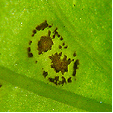 Pustules
Pustules
Symptoms
The upper leaf surface develops red, brown or yellow areas and the underside produces bright yellow to orange spores that correspond to the patches above. Infested leaves become brown in patches, fall prematurely and flower and fruit may also be infected. This overall, results in a loss of vigour and in small plants may lead to death.
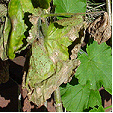 Pelargonium x hortorum
Pelargonium x hortorum
Myrtle Rust (Puccinia psidii) This fungal disease infects plants in the Myrtaceae family and was only recently detected in 2010 and has since spread across eastern Australia from the Northern Territory to Queensland, NSW, Victoria and Tasmania. This rust attacks soft and actively growing foliage or shoots with varying symptoms. It normally starts as small purple spots on the leaves from which spores form in yellow pustules that fade to grey as the infection matures and can merge creating leaf distortion and death of the plant.
The life cycle starts when the powdery yellow spores are distributed by wind to other plants where they germinate and start to grow by piercing the plant cells to obtain nutrients. Germination occurs in dark moist positions with a temperature between 15° to 25°C and the new pustules can release spores in 10 to 12 days, (spores remain viable for 3-months). The spores spread rapidly by wind, water, insects or animals. They are also distributed by plant material, clothing, shoes and vehicles.
 Puccinia psidii
Puccinia psidii
Needle Rust (Melampsora farlowii) infects the new leaves turning them to yellow and fall from the shoot giving the branch a scorched appearance. The fruiting bodies are found on the underside of the leaf and is waxy-red.
Rust in Poplar (Melampsora species). A fungal problem involving at least two species (Melampsora medusae) and (Melampsora larici-idaei).
The upper leaf surface becomes flecked with yellow to light green and the underside produces bright yellow orange spores that correspond to the patches above. Infested leaves become brown in patches, fall prematurely and shoots may die back as a result of not being hardened off to the elements. This overall, results in a loss of vigour and in small plants may lead to death.
The source of the fungus is from other infected plants or fallen leaves and is dispersed by wind.
Host plants include Lombardy Poplars particularly Populus nigra 'Italica' and cottonwoods.
White Rust (Albugo candida) forms snow white pustules that contain colourless spores that turn yellow then brown and are found on the underside of leaves.
White Pine Blister Rust (WPBR) is caused by the fungus (Cronartium ribicola). It is a obligate parasite requiring a living host to survive. The life cycle requires two host species with part of it life on the Pinus species and the other part on Ribes species. First cankers or sores appear on the Pinus species realising spores that land on the Ribes species infecting it. The infection produces a different type of spore that land on the needles and growing branches of the Pinus species and eventually forming cankers. The spores are spread by wind and prefer cool moist conditions. Symptoms include brown spots on the needles and the appearance of dead branches in the crown. Cankers will also appear on the trunk and it tends to attack young trees. Control methods include removal of Ribus species in the affected areas and breading naturally resistant Pinus species.
The Rust (Endophyllum sempervivi) affects Sempervivum species by infecting the young leaves and eventually the crown. The mycelium then travels to the roots and extends into any off shots. Leaves that are infected turn yellowish, grow longer and are thin. Persistent infection may kill the plant.
Source and Dispersal
The source of the fungus is from other infected plants or fallen leaves that contain the fruiting bodies and is dispersed by wind.
Favoured Conditions
Generally rust is more prevalent during summer, preferring warm humid conditions and particularly when the leaves are damp.
Affected Plants
A wide range of ornamental annuals, perennials, ferns, trees, shrubs including, Hibiscus species that are infected by Kuehneola malvicola predominantly in southern USA.
Abies species are infected by many types of rust including (Milesia fructuosa) and (Uredinopsis mirabilis).
Abutilon, Phymosia and Alcea species are infected by the rust (Puccinia heterospora).
Alnus species are occasionally infected with Leaf Rust (Melampsoridium hiratsukanum) which forms yellowish pustules on the leaves that develop turning the leaf brown.
Amelanchler species and Calocedrus decurrens are infected by several rust species including (Gymnosporangium libocedri).
Antirrhinum majus (Snapdragon) is infected by the rust (Puccinia antirrhini). This fungal problem that infects the epidermal layer on the leaf underside, forming pale green areas that are raised and split open revealing reddish brown spores that have a dusty appearance.
As the infestation grows, concentric rings of spore pustules appear around the original infection. The corresponding position on the upper leafs surface turns yellow eventually causing the leaf to wilt and die. The infestation is not restricted to the leaves; all above ground parts of the plant are susceptible and infected plants transmit the fungus dispersing it by wind.
Infected plants should be removed and destroyed.
Anemone and Prunus species are infected by the rust (Tranzschelia pruni-spinosae) that stimulates abnormal growth in the plant during spring.
Aquilegia, Anemone, Delphinium and Clematis species are infected by the Rust (Puccinia rubigo-vera var. agropyri).
Arctostaphylos manzanita is infected by the rust (Pucciniastrum sparsum) occurring in coastal regions but is not normally detrimental to the plant.
Artemisia species are infected by the rust (Uromyces ari-triphylli) which is a systemic disease that is transmitted through seeds. It causes the leaves to turn yellow then die and can infect all parts of the plant except the roots.
Bambusa species are infected by the rust (Dasturella divina) which forms elongated brownish strips on the leaves.
Berberis species may be infected by the Rust (Puccinia graminis) that forms orange spotting on the leaves. It certain regions plants infected with this rust must be removed and destroyed to avoid infecting neighbouring agriculture crops.
Betula species may be infected by Leaf Rust (Melampsoridium betulinum) that forms reddish-yellow spots on the leaves and heavy infestation can defoliate the tree. The host tree changes to Pseudolarix species during the sexual stage and causes blistering of the leaves.
Calendula species may be infected by the Rust (Puccinia flaveriae).
Callistephus and Solidago species may be infected by the Rust (Coleosporium solidaginis) which forms bright yellow spots particularly on new foliage or young plants.
Canna species may be infected by the rust (Puccinia Thaliae).
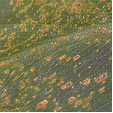
 Canna indica
Canna indica
Centaurea species are infected by the rust (Puccinia cyani) and (Puccinia irrequisita) which can cover the stems and leaves.
Cleome species are infected by the rust (Puccinia aristidae) but rarely requires control.
Dianthus species are infected by the rust (Uromyces dianthi) which forms powdery brown spots that appear on both sides of the leaves. The leaves curl and die and the plant becomes stunted. This is a common problem that occurs when grown in a protected enclosure (hot house).
Ficus species are infected by the rust (Cerotelium fici) which forms small brown spots, and causes the leaves to turn yellow then fall prematurely.
Fuchsia species are infected with (Pucciniastrum epilobii). This fungus caused purplish red blotches on the upper leaf surface, that become dry in the middle and result in a brown patch with purple edges. On the underside of the leaf, corresponding to the patches, yellow orange spores form. Heavily infected leaves become yellow and drop prematurely. This leads to a loss of vigour in the plant and infected plants transmit the fungus.
Certain cultivars are more susceptible than others, particularly 'Orange Drops' and 'Novella'.
Hydrangea species is infected by (Pucciniastrum hydrangeae) causing yellowish brown pustules to appear on both sides of the leaf. The leaf becomes dry and brittle.
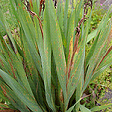
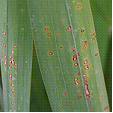 Iris species
Iris species
Iris and Dietes species are very susceptible to the rust (Puccinia iridis). Leaves form rusty red powdery spots that enlarge. They are appear on both sides of the leaves causing the surrounding area to turn pale yellow then brown and the black spores appear soon after, overwintering on dead infected leaves. Plants may be heavily infected but normally survive attack.
Larix species are infected by several Needle Rusts including (Melampsora paradoxa), (Melampsora medusae) and (Melampsoridium betulinum). The fungi attacks the needles predominantly towards the branch tips turning them yellow and eventually killing them . The underside of the leaf develops pale yellow fruiting bodies.
Lupinus species are infected by three species of rust including (Puccinia andropogonis var onobrychidis).
Malus andChaenomeles species may be infected by the rust (Gymnosporangium juniperi-virginianae) or (Gymnosporangium clavipes) which forms brown or bright orange spots on the leaves or twigs and can defoliate the tree. Juniperus virginiana and Mespilus germanica may also be infected by rust.
Mathiola and Arabis species are infected by White Rust.
Pinus species are infects by the Comandra Blister-rust (Cronartium comandre).
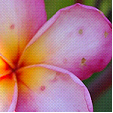
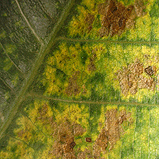
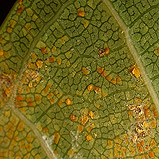
Plumeria rubra Leaf upper surface Leaf underside
Plumeria species are susceptible to the rust (Coleosporium plumeriae). Leaves and flowers may be infected with the underside forming bright yellow pustules and causes premature leaf or flower drop.
Populus nigra 'Italica' is infected by the rust (Melampsora species) which forms pustules to form on the leaves turning them brown and causing premature leaf drop.
Rhododendron and Tsuga species are infected by the rust (Pucciniastrum vaccinii) and is commonly found in nursery stock, spreading rapidly. Tsuga species are also infected by Needle Rust.
Ribes species are infected by the rust (Cronartium ribicola). This leaf rust appears on the underside of the leaves (preferably older leaves) forming dusty brown pustules and is a serious problem. This rust only appears when White Pine (Pinus strobes) grows near where the alternate stage of the fungus occurs.
Rudbeckia species are infected by several species of rust including (Puccinia dioicae) and (Uromyces rudbeckiae).
Salix species are infected by four types of (Melampsora species).
Senecio, Bellis and Calendula species are infected by the rust (Puccinia lagenophora) which forms blister-like pustules that release brown spores.
Sorbus aucuparia is affected by several rust from the (Gymnosporangium species) causing circular yellow spots, that appear on the leaves during summer and develop into orange cup-shaped fruiting bodies.
Trillium species are infected by the rust (Uromyces halstedii) that damages the leaf surface.
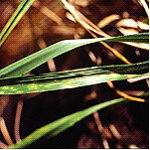 Festuca arundinacea
Festuca arundinacea 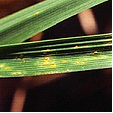 Rust
Rust
Turf Grass are susceptible to rust (Puccinia species) and (Uromyces species), causing yellow flecks to appear on the stems and leaves. These markings enlarge before the pustules form and in severs cases the lawn has a yellow, red or brown appearance.
The infection appears from spring to summer under humid low light conditions and turf that is under stress or with excessive nitrogen in the soil is more susceptible. Many species may be infected including Lolium perenne (Perennial Ryegrass) and Poa pratensis (Kentucky Bluegrass).

 Rust on Perennial Ryegrass
Rust on Perennial Ryegrass
Viburnum species are mildly affected by two types of rust (Coleosporium viburni) and (Puccinia linkii).
Viola species are infected by the rust (Puccinia violae) which forms green spots on the underside of the leaves. It is not commonly seen on cultivated plants.
Non-chemical Control
Cut off and destroy any infected branches, fallen leaves and remove heavily infected plants. Improve the culture by, pruning to improve air circulation, allow space between plants and avoid over crowding. Avoid planting susceptible species. Plants that are infected with a systemic form should be removed and destroyed
Chemical Control
Not possible to spray large trees but young plants may be treated with a protectant fungicide such as wettable sulphur. In a domestic garden small plants such as Fuchsia species may be sprayed with a protectant chemicals as symptoms appear, aided by the removal of existing infected leaves. Under commercial conditions stock may be sprayed with a fungicide such as oxycarboxin.
Note
Always read the label for registration details and direction of use prior to application of any chemicals.
Average Lowest Temperature : -3º C 27º F
USDA : 9, 10
This USDA (United States Department of Agriculture) hardiness zone chart can be used to indicate a plant’s ability to withstand average minimum temperatures. However, other factors such as soil type, pH, and moisture, drainage, humidity and exposure to sun and wind will also have a direct effect on your plant’s survival. Use this chart only as a guide, always keep the other factors in mind when deciding where, when and what to plant.
A plant's individual USDA zone can be found in the Plant Overview.
Climate Description
Warm Temperate
This zone has the majority of rain during winter in the west and summer in the east with high humidity. Summer temperatures may peak at 40ºC (104ºF).
Frost and drought mainly occur inland and coastal wind is normally accompanied with rain.
Plant growth
Wide range of native and exotic plants grow well.
| Dictionary | Growth Habit |
| Leaf Type | Botanic Flower Description |
| Leaf Shape | Flower Inflorescence |
| Leaf Arrangement | Fruit Type |
| Leaf Margin | Bark Type |
| Leaf Apex And Bases | Flower Description |